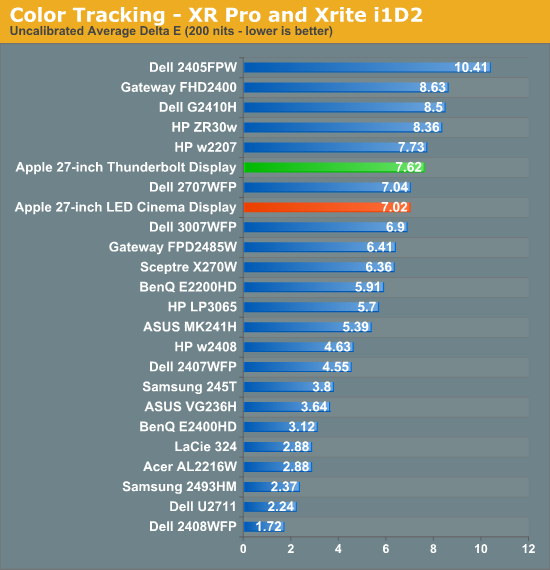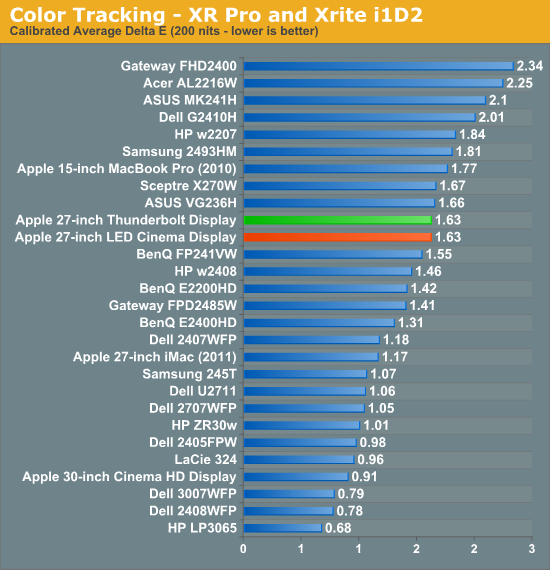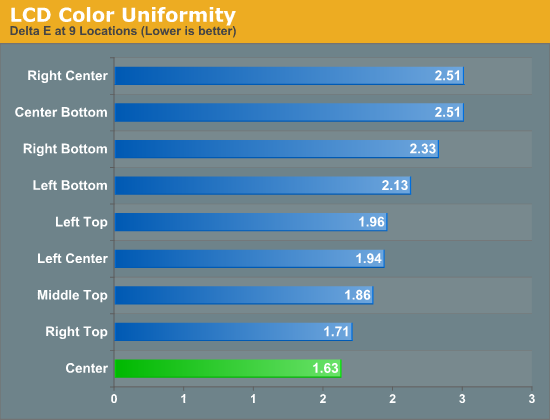The Apple Thunderbolt Display Review
by Anand Lal Shimpi on September 23, 2011 2:56 AM EST- Posted in
- Displays
- Mac
- Apple
- Thunderbolt
- Thunderbolt Display
Display Testing
With all of the extra connectivity there is to test with the Thunderbolt Display we can't forget the actual panel testing. Thankfully this part is pretty simple, the display characteristics are near identical to the 27-inch LED Cinema Display we reviewed last year.
Color Quality
We report two main quality metrics in our display reviews: color accuracy (Delta-E) and color gamut. Color gamut refers to the range of colors the display is able to represent with respect to some color space. In this case, our reference is the AdobeRGB 1998 color space, which is larger than the sRGB color space. So our percentages are reported with respect to this number, and larger is generally better.
Color accuracy (Delta E) refers to the display’s ability to display the correct color requested by the GPU and OS. The difference between the color represented by the display, and the color requested by the GPU is our Delta-E, and lower is better here. In practice, a Delta E under 1.0 is perfect - the chromatic sensitivity of the human eye is not great enough to distinguish a difference. Moving up, a Delta E of 2.0 or less is generally considered fit for use in a professional imaging environment - it isn’t perfect, but it’s hard to gauge the difference. Finally, Delta E of 4.0 and above is considered visible with the human eye. Of course, the big consideration here is frame of reference; unless you have another monitor or some print samples (color checker card) to compare your display with, you probably won’t notice. That is, until you print or view media on another monitor. Then the difference will no doubt be apparent.
As I mentioned in our earlier reviews, we’ve updated our display test bench. We’ve deprecated the Monaco Optix XR Pro colorimeter in favor of an Xrite i1D2 since there are no longer up-to-date drivers for modern platforms.
For these tests, we calibrate the display and try to obtain the best Delta-E we can get at 200 nits of brightness for normal use. We target 6500K and a gamma of 2.2, but sometimes the best performance lies at native temperature and another gamma, so we try to find what the absolute best performance could be. We also take an uncalibrated measurement to show performance out of the box using either the manufacturer supplied color profile, or a generic one with no LUT data. For all of these, dynamic contrast is disabled.

Uncalibrated performance remains fairly similar to last year's LED Cinema Display, however once calibrated the Thunderbolt Display is spot on with its predecessor:

As we mentioned earlier, a sub 2.0 delta E is good enough for professional use. Although not perfect the Thunderbolt Display falls within that range for sure.


We measured slightly lower color gamut on the Thunderbolt Display than the original LED Cinema Display, however the result was much closer to the 2011 27-inch iMac. I couldn't visibly tell any differences and Apple indicates that color gamut shouldn't have changed, so it's quite possible that the differences here are due to our colorimeter and not the panel.
Color Uniformity
Now for color consistency, we take our best calibration profile from the very center at 200 nits and test color accuracy at 9 different places around the LCD display in an evenly distributed grid. We’ve shown before that calibration is localized across the display, partly due to the brightness not being uniform, partly due to the discrete nature of the display itself.

The Thunderbolt Display was fairly uniform across its surface, something we noticed in reviewing the 27-inch LED Cinema Display last year. Uniformity is actually better on this panel than the one we reviewed last year, although in both cases I couldn't really tell any differences.
Peak brightness appears down slightly, but so are the black levels which result in a slightly better contrast ratio. Apple is also calibrating these things at the factory now so white points are now set at around 6300K vs. 7100K on the original 27-inch LED Cinema Display.










275 Comments
View All Comments
Anand Lal Shimpi - Friday, September 23, 2011 - link
We do not accept payment for any review, this one included.Take care,
Anand
Anand Lal Shimpi - Friday, September 23, 2011 - link
I needed to start somewhere :) The next video review won't be an Apple product ;) And we do try to take great photos of everything we review when possible. I believe some of the best photos to-date have been of Android smartphones imho done by Brian Klug.Take care,
Anand
Aikouka - Saturday, September 24, 2011 - link
It's a good review overall, but I do have a comment or two:- When switching to a completely different view, I would recommend using a quick transition such as a fade. It's rather jarring to just suddenly switch to a completely different picture like that.
- If you'd like to make video reviews a bit more common, it might be worthwhile to consider a slight site change to make them a bit more accessible. Some sort of thing (tabs, buttons, etc.) near the top to switch between a text review and a video review.
I'm trying to figure out though... did you build that entire stage area for the review, or is that a blue screen behind you? The shadows on the lettering made me wonder.
G-Man - Friday, September 23, 2011 - link
I'm guessing they make the extra effort on Apple-products, simply because A LOT more people read those articles than the odd generic laptop review.If you've been following Anandtech for a while, you will see that they recap and explain (basic) technology and concepts in Apple review, because more people read them, and less tech savvy people read them.
So it's only natural for them to put extra effort into Apple-reviews.
PS: Anand, LOVE the video review. Please keep making them! :)
gevorg - Friday, September 23, 2011 - link
Anandtech just loves Apple products, hence the special treatment. :)MrX8503 - Friday, September 23, 2011 - link
Maybe you're the fanboy. Its a good review just like any other, accept it.KoolAidMan1 - Monday, September 26, 2011 - link
B3an is definitely the fanboy, there is massive bias when he posts in DT threadsKoolAidMan1 - Friday, September 23, 2011 - link
Part of it is that Apple products generally photograph better than others. It is hard to polish a turd, no matter how well you frame or light it. On the other hand, a beautiful object can photograph well under most circumstances.As for effort into reviewing Apple products, it is generally because they are on the leading edge of physical interfaces, form factors, and technologies. Three years after the debut of the Macbook Air and now there is a massive push from other companies to deliver comparable machines.
The reasoning behind the Thunderbolt review is that it points to a very probable future for PCs, one in which your laptop is also your main computer. One option will be to have a laptop that plugs into a Thunderbolt hub (which may or may not be integrated into a display) which has all of your external devices and other things such as a dedicated desktop GPU, etc etc.
It is interesting how much anti-Apple bias there is here. I'm typing this on my PC but I"m not blind to how vital Apple is to the industry.
seapeople - Friday, September 23, 2011 - link
You're comparing the reviews Anand does himself to what some of the other editors do for cheaper/less advanced products. Look at Anand's SSD reviews (especially when its for a new/unique controller) and you'll see the same detail.Kristian Vättö - Saturday, September 24, 2011 - link
And at the same time, many SSD reviews consist of just benchmarks and a small introduction. Take for example the Samsung 830 SSD review, it's not that massive, mainly because Samsung isn't that big player.